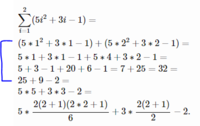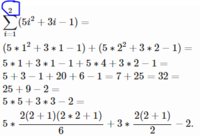bushra1175
Junior Member
- Joined
- Jun 14, 2020
- Messages
- 59
This is correct:
\(\sum\limits_{j = 1}^n {(5{j^2} + 3j - 1)} = 5\sum\limits_{j = 1}^n {{j^2}} + 3\sum\limits_{j = 1}^n j - \sum\limits_{j = 1}^n 1 \)
This is the same as if I said, [MATH](5x^2+3x-1)+(5y^2+3y-1) = 5(x^2+y^2)+3(x+y)-(1+1)[/MATH]. Can you see why that is true? There some of each of the associative, commutative, and distributive properties.[MATH]\sum\limits_{j = 1}^n {(5{j^2} + 3j - 1)} = 5\sum\limits_{j = 1}^n {{j^2}} + 3\sum\limits_{j = 1}^n j - \sum\limits_{j = 1}^n 1[/MATH]Hi, thanks for the reply. Could you please tell me how you came to that answer? I'm really struggling to understand. Please let me know
They say also, "Select all that apply".… They say "which represent" instead of "which represents" …
It's also an English test!
Why is the first one correct.
[MATH]\sum_{i=1}^2 (5i^2 + 3i - 1) =\\ (5 * 1^2 + 3 * 1 - 1) + (5 * 2^2 + 3 * 2 - 1) = \\ (5 * 1^2 + 5 * 2^2) + (3 * 1 + 3 *2) + (-1) + (-1) =\\ 5(1^2 + 2^2) + 3(1 + 2) - (1 + 1) =\\ 5\left ( \displaystyle \sum_{i=1}^2 i^2 \right ) +3 \left ( \displaystyle \sum_{i=1}^2 i \right ) - \left (\displaystyle \sum_{i=1}^2 1 \right ).[/MATH]You are just rearranging the terms of the sum and then factoring out common multiples.
But suppose we use the formula in the third line.
[MATH]\sum_{i=1}^2 (5i^2 + 3i - 1) =\\ (5 * 1^2 + 3 * 1 - 1) + (5 * 2^2 + 3 * 2 - 1) = \\ 5 * 1 + 3 * 1 - 1 + 5 * 4 + 3 * 2 - 1 = \\ 5 + 3 - 1 + 20 + 6 - 1 = 7 + 25 = 32 =\\ 25 + 9 - 2 =\\ 5 * 5 + 3 * 3 - 2 =\\ 5 * \dfrac{2(2 + 1) (2 * 2 + 1)}{6} + 3 * \dfrac{2(2 + 1)}{2} - 2.[/MATH]The formula does not save you any time when n = 2. But suppose n = 23?
Anyway, when they give you two correct answers and ask you to pick one, it's stupid.
EDIT: Wait a minute. I am the stupid one. They say "which represent" instead of "which represents" and thereby indicate that more than one answer is correct. It's also an English test!

He gave an example (as I did, also, in post #5) showing what the sum means in the case n=2 (that is, just two terms). So that was chosen from the start.Thank you so much. I can clearly see now how the first option equates to the original sum notation. However, I am confused about how you came to deduce that n = 2 for the third line. Was it by trial and error?
I can see in your breakdown that the highlighted part is just a simplification of the original sum notation. but I don't see how you plugged it in the formula with n being 2 below
View attachment 19781
Sorry for the confusion. I was asking why he replaced n with 2 and not any other number to show that the formula is correct, but I can see now that its because its 2 over here:
I am not sure what you are asking. n was just replaced with 2.

He gave an example (as I did, also, in post #5) showing what the sum means in the case n=2 (that is, just two terms). So that was chosen from the start.
